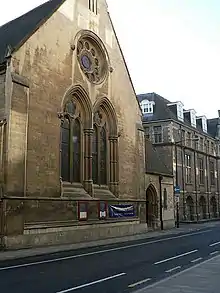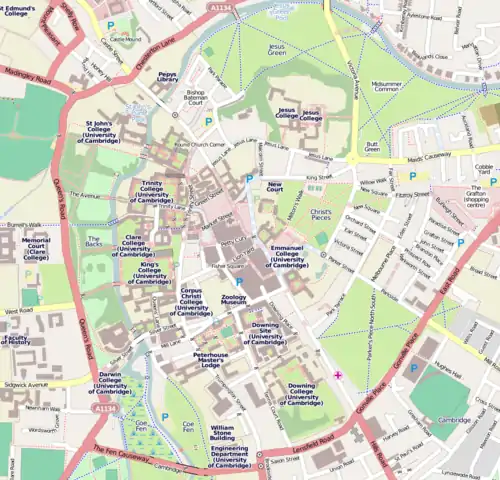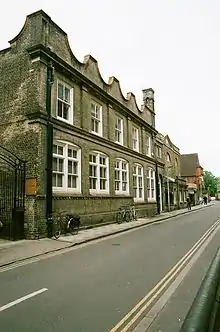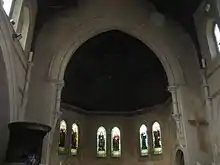Downing Place United Reformed Church, Cambridge
Downing Place United Reformed Church, Cambridge is a Protestant Christian church in Cambridge, United Kingdom. It was formed in 2018 in a merger between St Columba's United Reformed Church, Cambridge, and Emmanuel United Reformed Church, Cambridge. The church occupies the former St Columba's building in Downing Place, Cambridge, which is also close to a pre-1874 site once occupied by the Emmanuel's congregation. The church is part of the United Reformed Church. The current minister is The Revd Nigel Uden. As of August 2020 the church building is temporarily closed for major building works, with regular worship taking place in Westminster College, Cambridge until the building works are complete.[1][2][3]
| Downing Place United Reformed Church | |
|---|---|
 Downing Place URC viewed from Downing Street, Cambridge | |
 Downing Place United Reformed Church Location in Downing Place, Cambridge | |
| Location | Central Cambridge |
| Country | United Kingdom |
| Denomination | United Reformed Church |
| Website | https://downingplaceurc.org/ |
| History | |
| Former name(s) | Emmanuel URC, Emmanuel Congregational Church, Emmanuel Congregational Chapel, Hog Hill Independent Church; St Columba's URC, St Columba's Presbyterian Church |
| Administration | |
| Synod | URC Eastern Synod |
| Clergy | |
| Minister(s) | Revd Nigel Uden |
In the recent past prior to the merger of the two congregations, activities have included regular Sunday worship, a programme of music concerts, hosting an NHS group therapy centre and hosting a night-time drop in centre, and a night-time drop-in centre hosted by Cambridge Street Pastors. The refurbishment has been designed to facilitate similar activities are once the current refurbishment programme is complete.[1][2]
The pre-merger congregations both existed prior to the foundation of the United Reformed Church: Emmanuel was originally known as Hog Hill Independent Church, later becoming Emmanuel Congregational Chapel and then Emmanuel Congregational Church; St Columba's was known as St Columba's Presbyterian Church.
History
Emmanuel United Reformed Church



Historically a congregational church, Emmanuel voted to join the new United Reformed Church in 1972. Prior to the 2018 merger, Emmanuel United Reformed Church had been known by different names over the years, first as the 'Hog Hill Independent Church' and then the 'Emmanuel Congregational Chapel' or 'Emmanuel Congregational Church'.
The Emmanuel congregation was founded as the Cambridge 'Great Meeting' in 1687, at Hog Hill, the original building being there, on what is now the Old Music School in Downing Place. From 1691 the minister was Joseph Hussey;[4] he was commemorated in the stained glass in the apse of the former Emmanuel United Reformed Church building alongside John Greenwood, Henry Barrow, Oliver Cromwell, John Milton and Francis Holcroft. Hussey's congregation split in 1696, with some going to the meeting in Green Street, Cambridge, and again after he had left for London, in 1721, with a group founding the precursor of St Andrew's Street Baptist Church, Cambridge. The church was rebuilt on the same site in the later 18th century, opening as Emmanuel Congregational Chapel in 1790.[5][6] The move to the new church on Trumpington Street, called the Emmanuel Congregational Church, came in 1874.[5] The old chapel was put to use from 1881 as the Balfour Biological Laboratory for Women, for female science students in the University of Cambridge.[7] Prior to September 2020, Emmanuel United Reformed Church occupied a building on Trumpington Street, Cambridge. It was built to a design by the architect James Cubitt in 1875.[8] The building was sold to Pembroke College to form part of the college's Mill Lane development project.
In the years leading up to the merger, Emmanuel organised regular Sunday worship and a programme of community activities in the recent past: a volunteer-staffed fairtrade cafe, a series of lunchtime music recitals and a share in Hope Cambridge's Churches Homeless Project.
St Columba's United Reformed Church
St Columba's was historically a Presbyterian church. A Presbyterian congregation first registered in Cambridge 1689, at that time based in Green Street. The congregation of St Columba's was formally established in 1881, initially worshipping in Cambridge Guildhall. As of 1891, the present-day building on Downing Place had been built.[5]
In the years leading up to the merger, St Columba's, the church's programme included regular Sunday worship, hosting an NHS group therapy centre and a night-time drop-in centre hosted by Cambridge Street Pastors.[1]
Merger to form Downing Place United Reformed Church
In 2018, St Columba's United Reformed Church and Emmanuel United Reformed Church merged to form Downing Place United Reformed Church. The combined congregation occupies the former St Columba's building in Downing Place.[1] (The former Emmanuel building was sold to Pembroke College, Cambridge across the road in Trumpington Street, who intended to retain it as a lecture and performance area as part of their Mill Lane redevelopment. The merged congregation retained the use of the church building for a short period. The final service in the Emmanuel building took place on Sunday 26 July 2020 and all activities at Trumpington Street have now ceased.[2]
People
Former ministers have included:
- 1738–1754 John Conder[9]
- 1767–1788 Joseph Saunders[5]
- 1806–1817 William Harris[5]
- 1848–1854 George Burder Bubier[10][11]
- 1859–1865 Thomas Campbell Finlayson[10][12]
- 1871–1872 James Ward[13]
- 1894–1901 P. T. Forsyth[14]
- 1902–1909 William Boothby Selbie[15]
- 1910–1942 Henry Child Carter
And in recent years:
- Tony Coates;
- Derek Wales;
- Paul Quilter;
- Lance Stone; and
- John Bradbury.
Among the other people who have been associated with the congregation over the years, Michael Ramsey, who later became Archbishop of York, worshipped at what was then Emmanuel United Reformed church as a child, where his father was a deacon.[16]
References
- Curtis, Adrian (27 November 2019). "£3.3m vision is transforming iconic Cambridge church". Cambridge Independent. Retrieved 11 August 2020.
- Emmanuel United Reformed Church. "Home". Archived from the original on 11 August 2020. Retrieved 11 August 2020.
The last service to take place in the Emmanuel building was broadcast on Sunday 26 July .... Please visit our new website, Downing Place URC to follow us as we prepare to move to Downing Place as our permanent home ....
CS1 maint: unfit URL (link) - Downing Place URC. "Home". Archived from the original on 11 August 2020. Retrieved 11 August 2020.
... public worship will resume in September; and will take place at Westminster College while we await the completion of our refurbishment project on the Downing Place site.
- Atkinson, Thomas Dinham (1897). Cambridge Described and Illustrated. Macmillan. p. 173 – via Internet Archive.
- Roach, J. P. C., ed. (1959). "The city of Cambridge: Protestant Nonconformity". A History of the County of Cambridge and the Isle of Ely: Volume 3, the City and University of Cambridge. Victoria County History. pp. 135–183. Retrieved 2 August 2020 – via British History Online.
- City of Cambridge, vol.2 p.302 (1959), Royal Commission of Ancient Monuments
- Packman, Len (2011). "The Hopkins Building Jubilee Celebrations". Department of Biochemistry, University of Cambridge. Archived from the original on 7 October 2011. Retrieved 9 August 2011.CS1 maint: unfit URL (link)
- "Trumpington Street: Emmanuel United Reformed Church". Cambridge 2000: photos of Cambridge, England. Retrieved 2 August 2020.
- Briggs, J. H. Y. "Conder, John (1714–1781)". Oxford Dictionary of National Biography (online ed.). Oxford University Press. doi:10.1093/ref:odnb/6058. (Subscription or UK public library membership required.)
- Binfield, Clyde (1968). "Chapels in Crisis". In Taylor, John H. (ed.). Transactions of the Congregational History Society. XX. pp. 237–254 – via Internet Archive. (The most relevant text is on pp. 246-247.)
- "Bubier, George Burder (c.1823-c.1869)". Dissenting Academics Online. Queen Mary Centre for Religion and Literature in English, Queen Mary University of London. Retrieved 2 August 2020.
- "Thomas Campbell Findlayson". The University of Glasgow Story. Retrieved 2 August 2020.
- Sorely, W. R.; Romano, Terrie M. "Ward, James (1843–1925)". Oxford Dictionary of National Biography (online ed.). Oxford University Press. doi:10.1093/ref:odnb/36732. (Subscription or UK public library membership required.)
- Huxtable, John. "Forsyth, Peter Taylor (1848–1921)". Oxford Dictionary of National Biography (online ed.). Oxford University Press. doi:10.1093/ref:odnb/37424. (Subscription or UK public library membership required.)
- Jackson, Samuel Macaulay, ed. (1953). "Selbie, William Boothby". The New Schaff-Herzog Religious Encyclopedia. X. Grand Rapids, Michigan: Baker Book House. p. 338. Retrieved 2 August 2020 – via Christian Classics Ethereal Library.
- Commerford, Patrick (4 September 2015). "Where part of Salvation is for sale at £2 and Oliver Cromwell is among the saints". Patrick Commerford: an online journal on Anglicanism, theology, spirituality, history, architecture, travel, poetry, beach walks ... and more (blog).
Further reading
- Roach, J. P. C., ed. (1959). "The city of Cambridge: Protestant Nonconformity". A History of the County of Cambridge and the Isle of Ely: Volume 3, the City and University of Cambridge. Victoria County History. pp. 135–183. Retrieved 2 August 2020 – via British History Online. This gives the history of both the congregations that merged to form Downing Place United Reformed Church in c. 2019. The section 'Independents' describes the history of what would later become Emmanuel United Reformed Church; the section 'Presbyterians' describes what would later become St Columba's United Reformed Church.